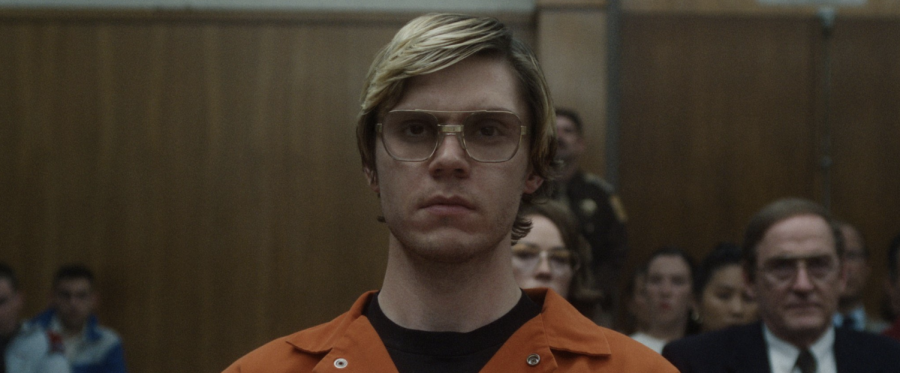Dahmer: An Unsettling but Worthwhile Watch for True-Crimers
Evan Peters in Dahmer – Monster: The Jeffrey Dahmer Story (2022)
The name Jeffrey Dahmer likely rings a sinister bell for most of those who hear it. “Monster: The Jeffrey Dahmer Story,” a limited Netflix series directed by Ryan Murphy, details the life and crimes of the infamous Milwaukee Monster, played by Evan Peters. This is the latest installment in a collection of Dahmer biopics since former Disney channel star Ross Lynch portrayed the killer in the 2016 movie “My Friend Dahmer.”
Each episode hops from year to year, showing glimpses of Dahmer’s childhood and adult life. Perhaps the most compelling aspect of the show is the unnerving peek we are given into Dahmer’s youth, particularly his early interactions with his father. In an attempt to connect with his detached son, Lionel Dahmer (played by Richard Jenkins), takes to participating in the one activity young Jeffrey seems to find pleasing: dissecting roadkill and examining the innards. What began as a father’s wayward attempt to connect with his son turns into an equally tragic and horrific moment that gives the viewer some explanation as to why Dahmer became the person he did.
In the last episode, Jenkins delivers a gut-wrenching performance during his last-ever meeting with his son. He tearfully responds to Jeffrey’s claim that the roadkill dissections are what sparked his morbid fascination with the human body, saying “This is not my fault! I did not do this to you.” It’s a very painful moment and one that is conflicting for the audience. Both parties are at fault, but how can such a blood-stained hand point the finger at anyone besides himself?
Peters’ uncomfortably convincing portrayal of Jeffrey Dahmer is a marvel to behold on the screen. Along with bearing much resemblance to the serial killer, Peters also nails the Wisconsin accent and creepy mannerisms of the murderer. Stealing the show from the titular character, however, is Niecy Nash. Nash portrays the fictional version of Dahmer’s real-life next door neighbor, Glenda Cleveland. During the three years in which the two lived in the same building, Cleveland made dozens of 911 calls because she could hear screams and loud mechanical noises coming from Dahmer’s apartment, as well as smell a very strong odor of rotting meat. Nash perfectly captures the desperation and fear that Cleveland must have felt during those years, knowing that murders were taking place next door but being able to do absolutely nothing about it.
This brings us to the real story within the story: the complete incompetence of the Milwaukee Police Department. Despite the dozens of frantic phone calls made by Cleveland, police officers never showed. Coincidentally, Dahmer lived in an apartment complex on the low-income side of town where the majority of residents were people of color. Dahmer was also a known homosexual who preyed primarily on other gay men of color. Now, enter a collection of racist Midwest cops in the middle of the HIV/AIDS epidemic and come to your own conclusion as to why the MPD never answered Cleveland’s pleas.
The series highlighted several instances where, had the police done their job even remotely properly, Dahmer would have been jailed before precipitating as much damage as he did. On one occasion, the stench of rotting meat coming from Dahmer’s apartment had gotten so bad that the entire floor had called to complain about it. The police arrived to assess the situation, which involved two police officers stepping inside Dahmer’s apartment for 30 seconds and then leaving because they didn’t want to “catch anything.” Had they looked around, they would have found a fresh dead body in the bedroom along with severed body parts and organs in the fridge, including an entire human head.
Not only did the police do nothing to prevent Dahmer’s crimes, they actually aided in his murder of a 14-year-old boy. Dahmer lured the child to his home and drugged him, but he escaped and stumbled out onto the street where Cleveland found him and called the police. The police arrived, but because the boy was unable to speak due to the drugs, the police led him back into the apartment after hearing Dahmer’s convincing claim that the boy was actually his 19-year-old boyfriend who had had too much to drink. Later that evening, Dahmer proceeded to drill holes into the boy’s head and fill them with acid in an attempt to create a human zombie.
“Dahmer” is a disturbing, multi-faceted watch that succeeds in every department but one: paying tribute to the most important and often-overlooked aspect of the story: Dahmer’s victims and their families.
Many are calling for the show to be removed from Netflix due to its insensitivity to the families of Dahmer’s victims. The sister of Errol Lindsey, one of Dahmer’s victims, told Insider that the show forced her to relive the trauma all over again. Another relative of Lindsey referred to “Dahmer” as a traumatizing media grab that attacks the black LGBTQ+ community. The families were not made aware of Netflix’s intention to produce the show or asked for their opinions, despite the fact that it portrays their real-life selves.
Director Murphy sometimes gets lost in his attempt to characterize one of the world’s most notorious serial killers, occasionally romanticizing Dahmer and his behavior when he should have been focusing on honoring the innocent lives taken at the murderer’s hand.















